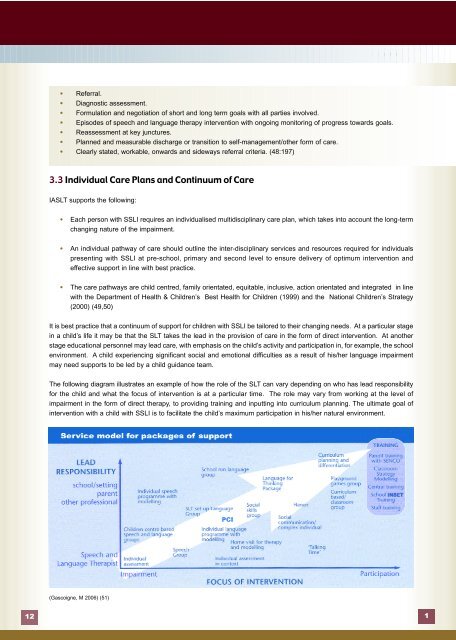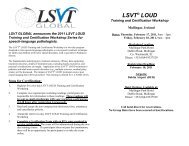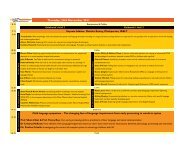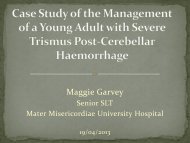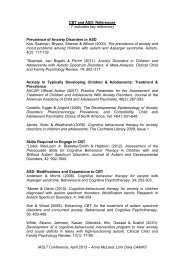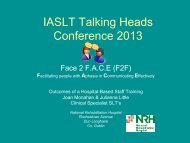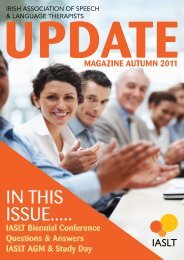Specific Speech and Language Impairment in Children - Irish ...
Specific Speech and Language Impairment in Children - Irish ...
Specific Speech and Language Impairment in Children - Irish ...
- No tags were found...
Create successful ePaper yourself
Turn your PDF publications into a flip-book with our unique Google optimized e-Paper software.
I.A.S.L.T.POSITION PAPER: OCTOBER 2007• Referral.• Diagnostic assessment.• Formulation <strong>and</strong> negotiation of short <strong>and</strong> long term goals with all parties <strong>in</strong>volved.• Episodes of speech <strong>and</strong> language therapy <strong>in</strong>tervention with ongo<strong>in</strong>g monitor<strong>in</strong>g of progress towards goals.• Reassessment at key junctures.• Planned <strong>and</strong> measurable discharge or transition to self-management/other form of care.• Clearly stated, workable, onwards <strong>and</strong> sideways referral criteria. (48:197)3.3 Individual Care Plans <strong>and</strong> Cont<strong>in</strong>uum of CareIASLT supports the follow<strong>in</strong>g:• Each person with SSLI requires an <strong>in</strong>dividualised multidiscipl<strong>in</strong>ary care plan, which takes <strong>in</strong>to account the long-termchang<strong>in</strong>g nature of the impairment.• An <strong>in</strong>dividual pathway of care should outl<strong>in</strong>e the <strong>in</strong>ter-discipl<strong>in</strong>ary services <strong>and</strong> resources required for <strong>in</strong>dividualspresent<strong>in</strong>g with SSLI at pre-school, primary <strong>and</strong> second level to ensure delivery of optimum <strong>in</strong>tervention <strong>and</strong>effective support <strong>in</strong> l<strong>in</strong>e with best practice.• The care pathways are child centred, family orientated, equitable, <strong>in</strong>clusive, action orientated <strong>and</strong> <strong>in</strong>tegrated <strong>in</strong> l<strong>in</strong>ewith the Department of Health & <strong>Children</strong>’s Best Health for <strong>Children</strong> (1999) <strong>and</strong> the National <strong>Children</strong>’s Strategy(2000) (49,50)It is best practice that a cont<strong>in</strong>uum of support for children with SSLI be tailored to their chang<strong>in</strong>g needs. At a particular stage<strong>in</strong> a child’s life it may be that the SLT takes the lead <strong>in</strong> the provision of care <strong>in</strong> the form of direct <strong>in</strong>tervention. At anotherstage educational personnel may lead care, with emphasis on the child’s activity <strong>and</strong> participation <strong>in</strong>, for example, the schoolenvironment. A child experienc<strong>in</strong>g significant social <strong>and</strong> emotional difficulties as a result of his/her language impairmentmay need supports to be led by a child guidance team.The follow<strong>in</strong>g diagram illustrates an example of how the role of the SLT can vary depend<strong>in</strong>g on who has lead responsibilityfor the child <strong>and</strong> what the focus of <strong>in</strong>tervention is at a particular time. The role may vary from work<strong>in</strong>g at the level ofimpairment <strong>in</strong> the form of direct therapy, to provid<strong>in</strong>g tra<strong>in</strong><strong>in</strong>g <strong>and</strong> <strong>in</strong>putt<strong>in</strong>g <strong>in</strong>to curriculum plann<strong>in</strong>g. The ultimate goal of<strong>in</strong>tervention with a child with SSLI is to facilitate the child’s maximum participation <strong>in</strong> his/her natural environment.(Gascoigne, M 2006) (51)121


